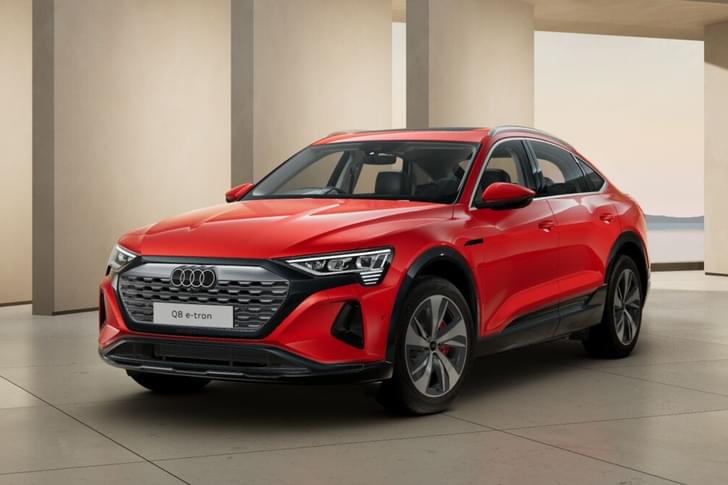Audi has just revealed its first all-electric series production model, the e-tron, at an event in San Francisco. The Audi e-tron is the third electric premium SUV to be revealed this year, taking on the Jaguar I-Pace and Mercedes EQC. Importantly, Audi is working towards bringing the e-tron to India and expected to introduce the electric SUV towards the end of 2019.
Audi’s first standalone electric model gets 400km of range on the WLTP test cycle – identical to the EQC but behind the I-Pace, which manages 470km. However, powertrain director Siegfried Pint told our sister publication Autocar UK that e-tron's homologation was ongoing and the range will be around 450km. A cheaper version with a smaller battery and, therefore, less range will follow in the next 12 months, Pint added.
The e-tron is the first production car in the world to offer 'virtual' side mirrors, which remove traditional door mirrors and instead use cameras with images appearing on screens in the door panels. However, the absence of regulation regarding this type of wing mirrors in India puts a question mark on if they’d make it to the e-tron for India.
Sitting between the Q5 and Q7 in size, the E-tron features a handful of design elements that are intended to make it stand out from other Audi models.
It keeps the single-frame grille but uses a lighter colour for the grille louvres. “We didn’t want to lose the single frame; it contributed to making us the premium brand that we are today,” said exterior designer Stephan Fahr-Becker. “We selected a lighter colour. If a car is approaching from 50 or 100 metres, the single frame is recognisable as an Audi but different from, say, a Q8."
The e-tron also gets a name badge on the front of the vehicle, in a similar vein to what Audi does with its RS performance models. “We were bold enough to put the name on the front of the car; we want to say the E-tron is the first of its kind,” said Fahr-Becker.
There are also specific wheel designs for the e-tron (“The task was to create aerodynamic wheels which still look sporty,” said Fahr-Becker) and orange hints – for example, in the name badge and optional orange brake calipers. “We took the colour from high-voltage cables. We wanted to create a special colour to accentuate that its electric,” Fahr-Becker added.
Aerodynamics also played an important part in the design to help with the e-tron’s range, said Audi, achieving a drag coefficient of 0.28. There is an air inlet with ducts for cooling the front brakes, as well as adaptable, speed-dependent air suspension and a fully clad underbody. The e-tron also sits slightly lower than a traditional SUV; at 1,616mm high, it is 43mm lower than the Q5.
The four-wheel-drive e-tron uses two asynchronous motors, one at the front axle and one at the rear axle, producing up to 408hp and 664Nm. In normal mode, it produces 360hp and is capable of 0-100kph in 6.4sec. At full power, in boost mode, it achieves 0-100kph in 5.5sec. Top speed is 200kph. Energy to power the motors comes from a 95kWh battery – the largest on the market and only matched by Tesla’s top-of-the-range Model S 100D.
Single-stage transmissions transfer drive to the wheels, and the lion’s share goes to the rear axle at moderate speeds. At full load, it will be a 50/50 split.
The car uses an energy recuperation system which, on average, contributes 30 percent to the range, says Audi. There are two ways: coasting recuperation when the driver releases the accelerator, or braking recuperation when he or she depresses the brake pedal.
Using 150kW public fast chargers, which are currently uncommon, the e-tron will be capable of charging up to 80 percent in 30 minutes. Audi is one of a number of carmakers (including BMW, Daimler and Ford) that have invested in charging network Ionity. Audi says the network should have nearly 1,200 150kW charging points running by the end of this year.
For at-home charging, there is a standard 11kW charger that charges the e-tron in 8.5 hours. An optional 22kW charger halves this time. For India, Audi is looking at offering charging hardware with the e-tron, rather than setting up a network of chargers. This could be a welcome move given that India lacks adequate charging infrastructure as EV adoption in India is still at a nascent phase.
The interior is in line with other Audi models with its Virtual Cockpit instrument display and two touchscreens – an upper 10.1-inch screen and a lower 8.8-inch screen – replacing most conventional controls.
The most notable difference is the optional addition of 7.0-inch displays in the front door panels near the dashboard for the camera-based side mirrors. The images from the cameras are shown on the screens and change views on the motorway, when indicating or parking. The driver can also control what he sees. The aerodynamic benefits of the virtual mirrors are said to create an extra 2.25km worth of range.
Audi claims the e-tron beats rivals for rear legroom and front and rear headroom. It has 660 litres of boot space, 160 more than the EQC. There's another 60 litres of storage space in the car's nose. The front space is intended to give easy access to charging cables, because the charging port is near the A-pillar on the driver’s side of the car (for left hand drive markets). Towing capability is 1,800kg.
Set to be imported as a CBU from Audi’s CO2-neutral plant in Brussels, the e-tron is said to be priced competitively for India but will be significantly more than traditional combustion engine models like the Q7. After availing a subsidy of Rs 1.5-2 lakh under the government’s FAME scheme, expect the e-tron to be priced above Rs 1 crore in our market.















































